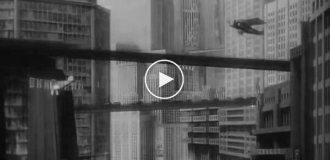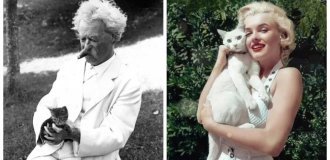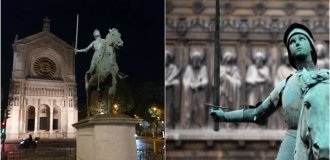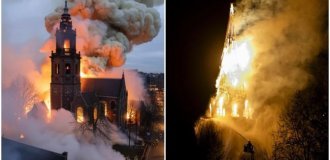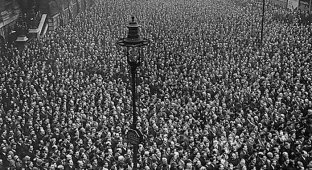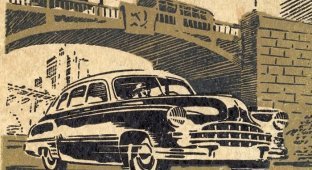

FIRST AIR ATTACK
STALIN'S "FALCONS" WERE GOING TO HUNT THE "STALLIONS" FROM MARANELLO
In the spring of 1952, two racing cars were delivered to the hangar of the Air Force motorcycle team of the Moscow Military District. Very soon, an image of the yellow-blue Air Force flag and the inscription “Falcon” appeared on their bodies. The commander of the Air Force of the Moscow Military District, Lieutenant General Vasily Iosifovich Stalin, took two international Formula 2 cars by plane from Chemnitz (GDR). They were designed by a team of designers who worked on the Auto-Union racing cars in the pre-war period. Immediately after the end of the war, these highly qualified specialists were united into the Scientific and Technical Bureau of the Automotive Industry (NTBA).
NTBA was one of the branches of the Soviet-German joint stock company Avtovelo, along with the former BMW automobile plant in Eisenach and other enterprises. One of the bureau’s works was the topic “55A” (“Racing car in the 2-liter class with a rear engine”) - in other words, a Formula 2 car (then they called “Formula B”). This class of racing cars, according to the FIA, was supposed to become a springboard for athletes to enter the Formula 1 arena and unite cars that were not as powerful and expensive as those in which the world championship was played. It was precisely this design that NTBA worked on, whose head was a representative of the Soviet administration V. G. Myshkin, and the acting director was the German specialist I. Wittber.
At that time, the world championship was dominated by drivers driving Italian cars Alfa Romeo and Ferrari. And when the first of the named companies, for financial reasons, decided not to start in the 1952 championship, it became clear that all stages would be won by Ferrari drivers and the World Championship would turn into “a one-sided game.” And the FIA decided to conduct it on Formula 2 cars.
There were already quite a few Formula B cars back then: Ferrari, Maserati, Gordini, ERA, Connaught, HWM, Veritas-Meteor, AWE - all with four- or six-cylinder two-liter engines with a capacity of 155-175 hp. With. These models, built with a front engine and rear drive wheels, weighed 660-800 kg and could reach a maximum speed of 220-235 km/h.
The former Auto-Union specialists were supporters of the rear-engine layout and 12-cylinder engines, and in the changed situation they intensified work on the “55A” topic, as they believed that there was a real chance for their car.
On the territory of the GDR it was then possible to find experienced racers to participate in the World Championship in domestic cars. True, R. Krause, P. Greifzu, K. Baum belonged to the older generation and, in terms of their capabilities, could not be compared with the world aces H.-M. Fangio, D. Farina or A. Ascari. But young, promising E. Bart and H. Melkus appeared on the sports scene.
The “650” model, designed and built by the “auto-unionists” from NTBA, made its first test trips around the bureau’s territory on March 31, 1952. To begin with, we didn’t take any risks: we drove 10 kilometers, maintaining the speed no higher than 3500 and not exceeding the speed of 115 km/h.
Adjustments began: selecting tire pressure, spark plugs, fuel, ignition timing, testing engines on a bench. We tried engines with four Solex carburetors, which had mixing chambers with a diameter of 19 mm, but the engine did not develop more than 4500 rpm. We installed other Solexes with 23 mm diffusers and achieved 5000 rpm. They worked methodically, step by step, but without wasting time - the first stage of the 1952 World Championship was to take place on May 18 in Bern, and the next one on June 22 in Spa. Therefore, the next trip to the test was not delayed. It took place on April 8. We drove 60 kilometers along the highway in the Bautzen area. In some sections, at 5000 rpm, it was possible to reach a speed of 175 km/h.
But soon an order came from above: both vehicles should be packed and delivered by plane to Moscow, at the disposal of the commander of the Moscow Military District Air Force, V. I. Stalin.

Ambitious plans to enter the arena of international racing, where Stalin’s “Falcons” should be accompanied by victories, fired the imagination. But before going abroad, Vasily Iosifovich still decided to try the Sokol-650 on the 23rd kilometer of the Minsk Highway near Moscow. There, near the village of Bakovka, car races usually took place. Not circular, but so-called “linear”, when athletes rushed along a straight or almost straight section of a highway 100 or 150 kilometers long, turned around a sign with the sign “turn” and raced back to the finish line. What speeds did they reach? At the 100-kilometer distance in September 1951, Kharkov resident Vladimir Nikitin drove a rear-engine streamlined car “Kharkov-3” with a 75 hp engine. With. reached a speed of 183.964 km/h, and at three hundred kilometers, Gorky resident Nikolai Sorokin driving a GAZ-Torpedo with a 2.5-liter 105-horsepower engine achieved a result of 165.899 km/h.
While the riders and mechanics from the MVO Air Force motorcycle team were getting used to the unfamiliar car, the first stage of the world championship took place on May 18 in Bern. Piero Taruffi won in a Ferrari with a two-liter engine producing 160 hp. s, showing an average speed of 143.9 km/h, and the maximum on straight sections was 220 km/h.
Alas, among our sports car drivers by that time only four (A. Ambrosenkov, E. Laurent, V. Nikitin and I. Pomogaibo) in their cars only exceeded the speed of 200 km/h several times, and other racers rarely crossed the 150 km barrier /h, and even then on straight lines.
Lieutenant General V.I. Stalin entered two “Falcons-650” into the Moscow championship on June 30, 1952. They were to be driven by Pavel Baranov, the then famous motorcycle racer of the Moscow Military Air Forces, and Vasily Kuznetsov, simply an experienced car driver.
The 23rd kilometer of the Minsk Highway, decorated with flags, was waiting for the participants in the morning: they walked in 27 cars of two classes. Eighteen crews (at that time the mechanic also acted together with the driver) on “Pobeda” and nine on “Muscovites”. The engines of the first developed a power of 70-78 hp. s, second - 32-34 l. With. The two-hundred-kilometer distance in the “victories” class was completed best by L. Dashkov - 136.560 km/h, and in the “Muscovites” class - by A. Gerasimov with a result of 113.566 km/h. Thus ended the race, which by its status should have been the “Grand Prize of Moscow”.
What about the Falcons? Alas, their engines did not want to run on all twelve cylinders. And the fuel was not right (the engine was designed for a complex alcohol mixture - after all, the compression ratio was 15.5), and, apparently, the spark plugs were not cold enough (heat number 280), and the ignition timing... In a word, they failed to fix these machines , and they didn't go.
And the temptation was very great. What about Nikitin’s or Pomogaibo’s homemade cars! “Falcon” with a 152-horsepower engine was designed for 260 km/h. But, apparently, it was not his destiny to become the first Soviet car that could start in the World Championship.
But, excuse me, why Soviet? Because Avtovelo was born in 1946, when the GDR did not yet exist. There was a Soviet occupation zone in Germany. And this Soviet-German society, which included NTBA, supplied BMW-321 and BMW-340 cars and BMW-R35 motorcycles to the USSR for reparations. Thus, all his products (and the racing car project too) belonged to our country.
However, in the summer of 1952, the Soviet government decided to transfer to the ownership of the GDR (this state was formed in October 1949) all joint ventures (including Avtovelo) along with their property. And the Falcons returned to their homeland. But time had already been lost and there could be no talk of any participation in the World Championship. NTBA was reformed into an industrial research institute; there was no money for experiments with Formula 2 racing cars, which, by the way, expired at the end of 1953. The cars became exhibits at the transport museum in Dresden. They returned to the race track only once - in 1959, when they were used as a car prop in the film “Rivals at the Wheel” (also shown in our country). There, the Falcons, lightly camouflaged, played the role of the cars of a mythical Latin American team that competes in international races with the GDR team, which competes in AWE racing cars.
When, when I was the head of the design group of racing cars at MZMA (now AZLK), I was looking for any drawings, diagrams, sketches, photographs of various racing cars and their components, I found a pile of old drawings in one of the cabinets in the photocopying department. There were about 80 or 100 kilograms of these blueberries - all with the stamp “model 650”. For my work on designing the Moskvich-G4, they were of no value, except perhaps for comparing some sizes. But for general education, the study of these blueprints turned out to be useful. I wrote out something for myself “in reserve,” took photographs of the car from the NTBA reports (and they were also found), and got acquainted with a solid volume of calculations for the Sokol project (it was kept in the archives of the department of the chief designer of the MZMA).
And now I know, apparently, a little more about this car than Peter Kirchberg himself, the author of the solid book “Grand Prix Report of Auto-Union for 1934-1939.” It was published in the first edition in the GDR in 1984, contained unique data on the entire work of the Auto-Union racing department, and mentioned in passing the NTBA and its brainchild. The author claimed that the Sokol engine was an engine of the racing model “E” increased in displacement (from 1482 to 1992 cm3), which Auto-Union had been preparing since 1939 for the new, one and a half liter racing formula. Meanwhile, both motors do not have common basic dimensions. For example, Auto-Union-E and Sokol-650, with the same number of cylinders, have different block angles: 60 and 65°, respectively. Both the center-to-center distances of the cylinders (76 and 84 mm), and the diameters of the main and connecting rod journals of the crankshaft (55 and 50 mm), and the center-to-center distance of the connecting rod (130 and 128 mm) are different. In other words, two designs that are completely different in “build”, in the most important initial dimensions, but common in engineering style, in school.
Let's take the general layout of the Falcon. The frame is made of two side members (chrome-molybdenum tube with a diameter of 85 mm and a thickness of 2 mm) and is identical in design to the “auto-unions”. , The power unit is also behind the rider. The front wheel suspensions are similar in design. The location of two on-board gas tanks, the design of the body, a removable steering wheel, brake drums made of aluminum alloy and many other parts clearly reveal the Auto-Union design school.
The engine follows to a lesser extent the traditions established in the racing department of the Saxon company. For example, the Sokol has two camshafts (2ONS design) in the cylinder head, while the Auto Unions have a design in which two heads are served by three “upper” camshafts.
At the same time, both engines have wet cylinder liners in a silumin cylinder block, both have two valves per cylinder and a circulating lubrication system.
As for the transmission, there is a difference in everything: the material of the gearbox housings and the main gear (the Sokol has magnesium alloy, not silumin), the relative position of the box and the engine (the Sokol has it between the engine and the main gear), the presence synchronizers (Auto-Union does not have them), type of main gear (Falcon has a hypoid gear, not bevel gears).
In a word, we can conclude that in Sokol the basic concept of the Auto-Union school was preserved, but the solution to specific technical problems was different. Therefore, it cannot be said that “Falcon” is a further development of “Auto-Union-E” (by the way, not a single sample of it was built).
When analyzing the Falcon drawings, I involuntarily compared them with the design of “auto-unions”, which was known to me not only from post-war NAMI reports (the institute had several of the eighteen machines brought to the USSR in 1945), from the books of L. Pomeroy and K. Edler. I got the impression that Myshkin was forced to supplement the original NTBA staff with specialists who were far from racing cars.
I think so because the transmission of pushing and braking forces from the rear wheels to the Falcon frame was carried out through short transverse forged arms associated with torsion bars and an A-shaped lever above the main gear - like on a passenger BMW 326 and in the style of the "Beamvist" » engineers. The engine was literally strangled by the intake manifold, through which the mixture was fed into the cylinders from four Solex carburetors - not six, as one would expect.
The transmission turned out to be excessively heavy. Despite the crankcases cast from magnesium alloy, its weight reached 80 kg. It is appropriate to remember here that the five-speed Auto-Union-S gearbox, interlocked with the main gear, was 43 kg lighter, although it transmitted 5.3 times more torque than that of the Falcon. Such a huge difference is the result of the introduction of four synchronizers into the Falcon box, which are completely unnecessary for a racing car. The transmission appears to have been designed by car specialists rather than race car specialists.
The same can be said about the engine. If we compare it with the 16-cylinder Auto-Union-S engine (6010 cm3, 520 hp), equipped with a supercharger, we will see that the Sokol power unit, three times smaller in displacement and developing 3.3 times less power, weighed 198 kilograms versus 245 kilograms for Auto-Union. The body also turned out to be heavier (55 kg versus 34.5).
As a result, Wittber ended up with an overweight car for his racing formula with an engine of insufficient power. Even if the circumstances had been favorable: Stalin Jr. would not have shown interest in the car and the GDR team would have entered the start of the world championship, the Falcons would not have brought it luck. The project was ambitious, but potentially unsuccessful. In addition, the car had to be equipped with random carburetors and spark plugs, as well as imported tires. In the GDR, the Riza company then made only 16-inch racing tires.
For fans of motor sports in our country, “Falcons” remain only in the memory of eyewitnesses of their only start near Moscow 41 years ago and ten photographs of its components placed in the now half-forgotten book by A. Sabinin “High-Speed Cars”, published in 1953 by the publishing house “Fizkultura” and sports." However, in Germany this car, which has neither a name nor a manufacturer's mark there, is also practically unknown.
Lev SHUGUROV
“Falcon-650” in all its glory: a duralumin body, a quick-release steering wheel, protruding “chines” above the on-board gas tanks, 17-inch Rudge-Whitworth wheels with a central nut.

Each of the four Solex carburetors fed three cylinders with a combustible mixture. Two magnetos (each serving its own bank of cylinders) were driven from the rear ends of the intake camshafts

The front suspension is of the Porsche type with transverse torsion bars. Shock absorbers are hydraulic lever. Water and oil are supplied to the radiators through four large-diameter durite hoses.

The gearbox on the Falcon is not behind the main gear, but in front of it. Along the frame tube there is a longitudinal torsion bar for the rear wheel suspension. The aluminum brake drum is equipped with fins, and small holes are provided in them - also for cooling air.

The rear wheels are connected by a De Dion tubular beam. Reaction forces are transmitted to the frame by forged torsion bar transverse arms and a longitudinal wishbone. Shock absorbers are hydraulic lever.

Falcon's first and last start in racing. The yellow and blue stripes on the rider's helmet indicate that he represents the MVO Air Force team.

A twelve-cylinder two-liter engine with four camshafts (two for each cylinder block). A vertical aluminum cylinder (visible in the foreground) played the role of an expansion tank in the cooling system.






Technical characteristics of "Falcon-650"
General dаta: dry weight - 632 kg; curb weight (with filling with water, fuel, oil) - 790 kg; weight distribution (with rider) - 46% front and 54% rear; fuel reserve—150 l; design speed - 260 or 275 km/h depending on the final drive ratio. Dimensions, mm: length - 3800; width—1500; height - 850; base - 2550; front track - 1240 mm, rear - 1250; ground clearance - 125; tire size: front - 5.50-17, rear - 6.50-17. Engine: number of cylinders - 12; cylinder diameter - 62 mm; piston stroke - 55 mm; working volume—1992 cm3; compression ratio - 15.5; valve mechanism - 2ONS; carburetors - 4 single-chamber vertical "Solex-32"; power—152 hp/ 111 kW at 8000 rpm; highest torque—16.4 kgf-m at 4000 rpm; weight—198 kg. Transmission: clutch—double-disc, 197 mm in diameter, in an oil bath; gearbox - 5-speed with synchronizers in 2nd-5th gears; gearbox power range - 2.2; The main gear is hypoid with a gear ratio of 4.15 or 4.583. Chassis: frame - spar made of pipes with a diameter of 85 mm; The front wheel suspension is independent torsion bar, the rear wheel suspension is “De Dion” torsion bar; brakes - drums with a diameter of 350 mm with four pads on each wheel; steering mechanism - worm and nut; the number of steering wheel revolutions from lock to lock is 2.04. Body: duralumin, width - 1150 mm.
PART TWO
“For racers, this “competition” is tantamount to playing with death. The owners demand the highest speed, a fight for every second, because at these competitions automobile concerns throughout the capitalist world fight for the primacy of their brands...” This is what the Soviet Sport newspaper wrote in January 1955 about foreign auto racing competitions.
These words concentrated the official attitude towards international motor sport in our country, the desire to present it just like that. And, of course, in those years, only a few knew for certain what the World Championship, Formula 1 racing, was. The first revelation in this regard was the book by S. Glazunov, A. Sabinin and L. Bas “Automobile and motorcycle competitions abroad.” It was signed for publication on January 30, 1956. And in the fall of the same year, on October 15, the Central Automobile Club of the USSR became a member of the International Automobile Federation (FIA). Then, in July 1958, the FIA approved two speed records set by A. Ambrosenkov and E. Laurent as international. August of the same year was marked by the debut of Soviet motorsports athletes abroad, at the 1000 Lakes rally in Finland. Three years ago, in August 1961, the first international automobile races took place on the territory of the Soviet Union.
Our sports delegations visited one of the stages of the World Championship as observers. Leonid Leonidovich Afanasyev spoke about what he saw at the Silverstone track in one of the issues of the magazine “Behind the Wheel”. By the way, he, along with A. Ipatenko, V. Marzhetsky, A. Sabinin, was elected to the governing bodies of this Federation at the FIA autumn congress in 1959. At the same time, the Congress heard an information report on the development of motor sports in our country.
It is quite natural that our sports organizations (FAS USSR, TsAMK USSR, sports clubs), in the context of the onset of the thaw, sought to somehow get closer to the international level, to introduce similar regulations for competitions, rules for their conduct, a sports calendar, types of competitions and, of course, classification of cars . This is how we got Formula 1, a class of racing cars, the technical requirements for which were close to international ones. Back then, we believed that a formal classification would push the auto industry to create cars like the Ferraris and Maseratis of the day.
These good intentions seemed like a utopia. Our Formula 1 became purely national. Various cars, mostly homemade, fit into its frame. The base for them was the components of serial machines. They were manufactured individually, and only the GA-22, KVN-3000G and Moskvich-G4 were able to be produced in batches of three or more copies.
Valery Shakhverdov, driving a GA-22 car, became the country's first champion in national Formula 1 in 1960. The front engine, dependent rear wheel suspension and three-speed gearbox on foreign Formula 1 cars had already become an anachronism.

The KVN-3000G was lighter than the GA-22, had a more powerful engine, but did not have an advantage over rear-engine vehicles. In 1966, on the Nevskoye Ring track, the best lap on this car was 1.43.0 versus 1.40.4 for the rear-engined Moskvich-G4A.

"Moskvich-G4", which debuted in 1963 (in the picture - under the control of Yu. Chvirov), conceived as nothing more than a Junior formula car, due to formal features, unexpectedly made a meteoric rise to Formula 1.

Probably the most notable vehicle was the GA-22, built at the auto repair plant of the Leningrad Military District under the leadership of V. Shakhverdov, in the amount of three copies. Very low, it was somewhat reminiscent of the contemporary Formula 1 Maserati 250F. The GAZ-21 engine was placed on its left side, and the driveshaft passed to the right of the driver, who was separated from the bottom by a thin cushion.
All components of the car were connected by a very torsionally rigid frame - in the form of a spatial tubular truss. The front wheel suspension is a converted Volga unit. The rear axle is also converted from a GAZ-69. Its main gear is shifted to the right, and the axle shafts are of unequal length. The bridge is suspended on four longitudinal quarter-elliptic springs. The brakes, alas, are drum brakes and are of modest size.
It is impossible to compare the GA-22 with the Formula 1 cars of that time (1958-1960). The only things they had in common were the working volume (2.5 liters) and the layout. For example, the Maserati 250F had three times the power and was 40 percent lighter in weight. It is worth noting that this car has five gears, and since 1959 it has already been equipped with disc brakes. And in terms of maximum speed, real Formula 1 cars were faster than national Formula 1 cars - 270 km/h versus 200.
Yes, the commonality was purely formal, especially since in the period 1958-1960 the design of Formula 1 cars abroad underwent qualitative changes. Almost all models began to be made according to the rear-engine design, the width of the bodies was reduced to 650-680 mm, the brakes were exclusively disc, the wheels were universally cast from light alloy, the wheel suspension was independent. The specific power of the engines reached the level of 115-95 hp. s./l, and the weight of the machines, thanks to new technical solutions, decreased to 400-450 kg.
Further development of the front-engine design in the domestic KVN-3000G vehicle did not make it possible to reduce the sharply increased gap. Our first rear-engine “formula” was the Moskvich-G4, with independent suspension on all wheels, rack and pinion steering, a narrow body and a semi-recumbent rider position. But, unfortunately, this car could not compete not only with Formula 1 cars, but also with Formula 2 or 3 cars. Even the next racing Moskvich model G5, having an engine with two camshafts in the cylinder head, was significantly inferior to its foreign classmates. The specific power of its engine was 67 hp/l. and, as further experiments showed, could not be raised above the level of 75 liters. s./l. It is not surprising that, despite the 5-speed transmission, the Moskvich-G5A, weighing 600 (!) kilograms, covered a kilometer with a standing start in 29 seconds. Its contemporary is the racing Matpa-MS7 with a 1600 cc Ford engine producing 215 hp. With. covered a kilometer from a standstill in 22 seconds. Therefore, it will hardly come as a surprise that in 1970 Yu. Andreev became the champion in national Formula 1, driving a De Sanctis Cosworth. It was a Formula 3 car, and it was five years old. However, its low weight (about 400 kg) and powerful engine (about 95 hp with 998 cm3 of displacement) made it possible to compete on equal terms with racing cars that had engines with a displacement of 1600 and 3000 cm3.
Moreover, once, in 1969, the FAS USSR raised the “bar” of national formula 1 to 7000 cm3, while at that time international formula 1 prescribed a maximum displacement of 3000 cm3.
The two ZIL-112S sports cars that remained “unemployed” (in 1968 and henceforth the national championship in the sports car class was not played) touched the hearts of the leaders of the Federal Antimonopoly Service of the USSR, and they expanded the “formula” framework for 1969.
The Moskvich-GD1 car (see AMC, 1993, No. 2), which was closest to the competitive designs of the international Formula 1, which was in force until January 1, 1966, never took the start line. It is a pity that only in 1971 the HADI-8 car was able to be presented at the USSR championship. It was originally conceived with a V-twin engine of the original design. The radiator was installed in the rear of the car, the nose of the body had a rounded shape. In combination with the suspension of the front wheels on springs retracted inside the body, this design feature provided the car with good aerodynamics. But, unfortunately, the technically interesting machine was not completed and remained only a milestone in history. Perhaps, with the proper attention and funding, HADI-8 could be a breakthrough to a higher technical level. It is unlikely that this car would be comparable to the best examples presented at the World Championship in 1971, but, in any case, it could attract some attention to domestic racing technology abroad.
MADI-01 turned out to be more successful. In 1973, S. Gass de Calvet won almost all the races of the season with it, except the national championship. It was a very successful model, by the way, one of the first with on-board radiators. The power unit was an experimental 6-cylinder V-shaped engine GAZ-24-14 with a power of about 150 hp. With. Such a car also needed extensive development and, apparently, could have been invincible in intra-Union competitions for a number of years.
June 1970. USSR Championship in Minsk. The start of the race in so-called Formula 1 cars is a very motley “company”. In the first row: No. 65 - fQ. Andreev (“De Sanctis Cosworth”); No. 4 - M. Live (“Estonia-14-Volga”); No. 1 - Yu. Markov (“Estonia-16-Volga”). In the second row: No. 35 - A. Argentov (“Kyiv-6-Volga”); No. 34 - Yu. Frolov (“Hange-Special-Volga”).

Narrow body with a well-streamlined nose. A V-shaped 8-cylinder engine, pneumatic independent suspension on all wheels - these are the features of the HADI-8, the design of which could have a great future in our motor sports.

But no matter how formal our national Formula 1 was, it united participants in the most powerful and fastest cars. It was quite natural to see at the start, next to the “dinosaurs” of the older generation, the front-non-engine KVN-3000G, “Hange-Special” or “Kiev-6”, the miniature “Melkus-Wartburg” with a 1000 cc (85-90 hp). ) three-cylinder engine. Y. Andreev, G. Surguchev, and V. Grekov successfully competed in such cars in F1. The tone, however, was set by combinations of the Estonia-16 chassis in various modifications, equipped with forced GAZ-24 or Moskvich-412 engines.
Pay attention to the radiator located in the tail of the HADI-8, the engine with two camshafts in each cylinder head, wheels cast from aluminum alloy, and elastic wheel suspension elements tucked inside the body.

A relatively powerful (125 hp) and reliable engine allowed Hess de Calve to win almost all races at MADI-01 in 1973, except, alas, the national championship. However, on the Nevsky Ring track in 1973, he set a single lap record of 1.30 - a very high result for that time.

M. Live in the national formula 1 car “Estonia-14-Volga”. It was a light and reliable car, “grown” from the old Formula 3 model. Boosted to approximately 100 hp. With. The Volga engine, tilted slightly to the left, is equipped with two twin carburetors.

One should not be deluded by the fact that for 14 years in the USSR the national championship was played in the so-called formula 1. Already in the last years of its life, it began to unite those whose cars did not correspond to the most common formulas 3 and “Vostok” in the country, in fact turning into a free formula . So, apparently, without unnecessary ambitions, it should have been called from the very beginning. Moreover, the industry, with the exception of AZLK, has not made any attempts to actually create a car that complies with international formula 1.
And the country's strongest racers gradually moved to the Vostok formula. Since 1977, F1 has disappeared from our national classification.
"Moskvich-G5A" in the latest version with a 124-horsepower engine and disc brakes. By 1977, when national Formula 1 died, he could still finish first.

L. SHUGUROV. Photo from the archive of Yu. Kleinerman and the magazine “Behind the Wheel”
Champions of the USSR in circuit car racing with Formula 1 cars
1960 V. Shakhverdov (Leningrad) GA-22
1963 Yu. Chvirov (Moscow) "Moskvich-G4"
1964 G. Surguchev (Moscow) "Melkus-Wartburg-63"
1965 V. Shchavelev (Moscow) "Moskvich-G4"
1966 V. Bubnov (Moscow) "Moskvich-G4A"
1967 E. Pavlov (Leningrad) ASK
1969 V. Rzhechitzhkiy (Moscow) "Moskvich-G5"
1970 Y. Andreev (Moscow) "De Sanctis Cosworth"
1971 M. Live (Tallinn) "Estonia-14-Volga"
1972 Yu. Terenetsky (Moscow) "Moskvich-G5M"
1973 N. Kazakov (Moscow) "Moskvich-G5M"
1974 X. Saarm (Tallinn) "Estonia-17-Volga"
1975 G. Dgebuadze (Tbilisi) 'Estonia-1 BM-Moskvich
1976 V. Grekov (Krasnodar) "Estonia-18"
National formula 1 racing cars
Vehicle/Year of construction/Number and displacement of cylinders/Number of carburetors/Valve mechanism/Power (hp) and rpm/Base engine/Number of gears/Base, mm/Curb weight, kg/Top speed, mph
GA-22 1958 4—2445 2 OH 84—4000 GAZ-21 3 2380 900 200
KVN-3000G 1964 4—2898 2 OH 115—5400 GAZ-21 3 2400 690 210
"Moskvich-G4A" 1965 4—1358 4 OH 81—5500 "Moskvich-408" 4 2350 550 180
HADI-8 1967 8—1974 1 2ONS 340—6500 — 5 2600 550 200
"Estonia-14" 1968 4—2445 2 OH 110—4000 GAZ-21 4 2350 550 200
"Moskvich-G5A" 1972 4—1840 4 2ONS 124—6000 "Moskvich-412" 5 2284 600 200
MADI-01 1973 6—2998 1 OH 125—5400 GAZ-21-14 5 2480 736 204
"Estonia-17" 1974 4—2445 4 OH 130—4000 GAZ-24 5 2350 550 200
